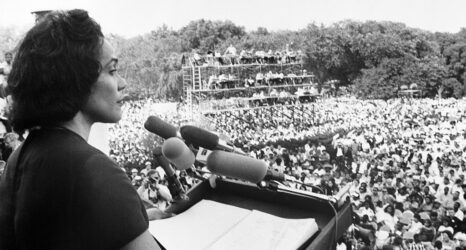On this day, the late Bob Marley would have turned 67 years old. In honor of the “soul rebel” who encouraged Jamaicans and the rest of the world to embrace a Black consciousness and support liberation struggles, I invoke the memory of another Jamaican hero for our Black “Herstory” Month series: the fierce fugitive slave Nanny of the Maroons.
Nanny is thought to be a member of the Ashanti Kingdom of West Africa brought to Jamaica as a slave in the 18th century. She led a community of fugitive slaves (or “maroons”) in the rain forest called Nanny Town. Legend has it that through the 19-year “First Maroon War” she held out against the British colonizers and slaveowners through both militaristic and magical powers, defeating English armies by catching bullets in her buttocks and hurling them back. It is believed that she died in battle around 1734.
You can find historical accounts of Nanny of the Maroons in Jenny Sharpe’s Ghosts of Slavery and in Madeleine Burnside and Rosemarie Robotham’s Spirits of the Passage. But I am not very concerned with distinguishing between what of Nanny’s story is factual “history” and what is simply “myth.” As an interdisciplinary Black feminist scholar, I tend to agree with Trinh T. Minh-ha in her phenomenal Woman, Native, Other, when she reminds us that Western historians and anthropologists long dismissed the vast historical knowledge of indigenous women since its tellers refused to distinguish between what was “just a story” and what “really happened.” When receiving the history of a Jamaican icon like Nanny, is it important to debunk if she really had magical powers? Scholar Raquel Z. Rivera, who coined the theory of liberation mythology, says:
I look at myths not as stories or beliefs that are (necessarily) untrue but as tropes that poetically attempt to explain or get us closer to the unexplainable. The myth may or may not be true; my aim is not to determine if it is or if it isn’t true, but to explore the ‘dreams of freedom’ at the root of myth-making.
Myths, says Rivera, allow us to look back at the past to imagine larger-than-life outcomes and possibilities.
Today, Nanny of the Maroons is officially recognized as one of Jamaica’s national heroes (the only woman among seven). She is featured in the Jamaican Heroes National Park and appears on the Jamaican $500 bill. Jamaican author Michelle Cliff included Nanny in her novels Abeng and Free Enterprise. Not too long ago, Jamaican American artist Renee Cox featured Nanny as a subject in her art series, Queen Nanny of the Maroons.
Nanny is yet another Black woman of history whom we can look to as a model of successful strategies of resistance. May we pour libation for these spirits who quite literally placed their bodies on the line for our freedoms.
Read More:





